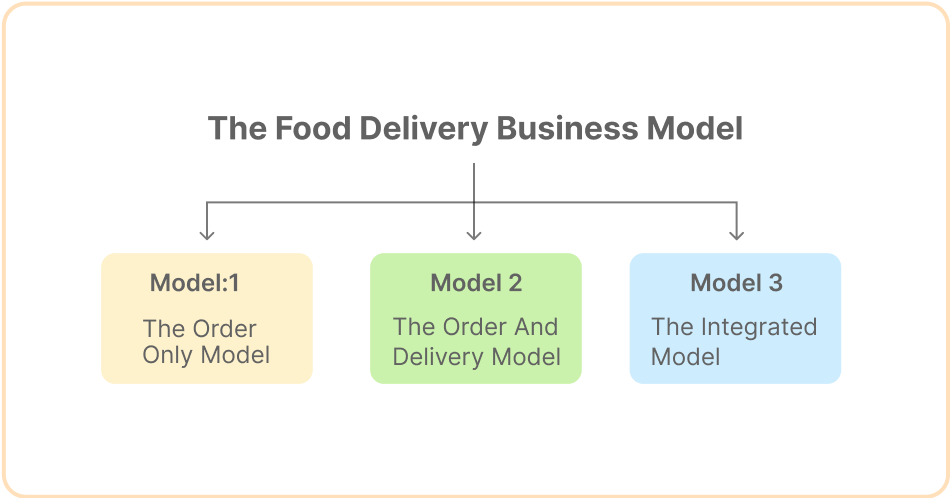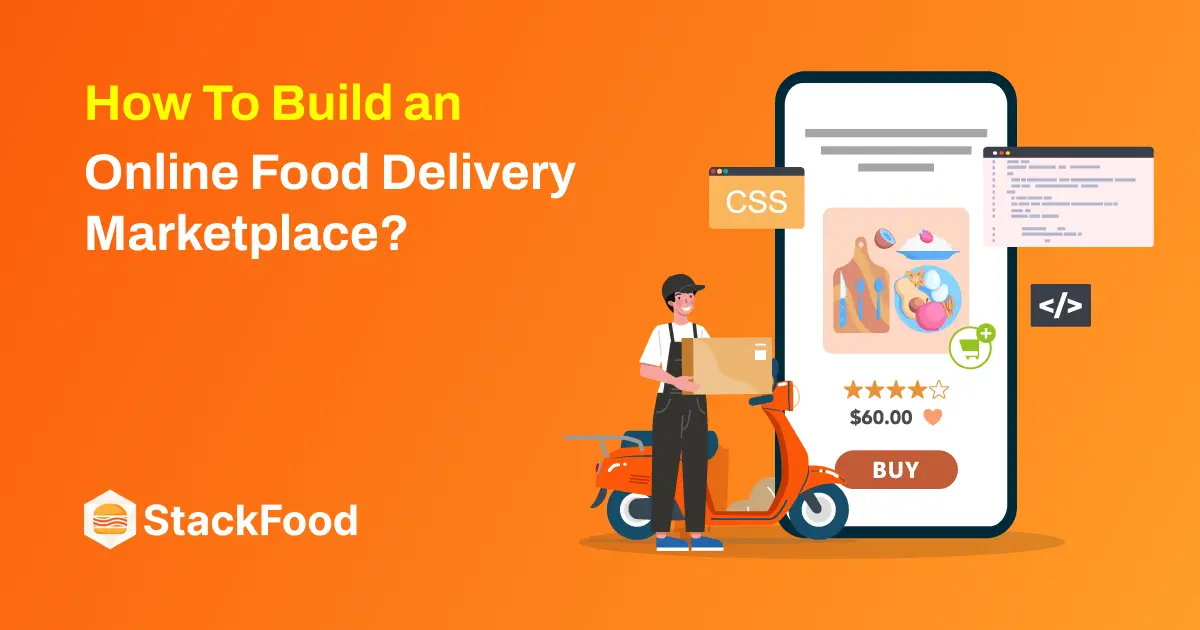Seeing all the success of online food delivery marketplaces, my developer friend started hunting for clients through freelance marketplaces. Guess what? He found one with a great deal. Now, here comes the twist. Even if he found his long-desired client with a project he was so excited about – he lacked knowledge on the 3 W’s – what, who, where. He didn’t know-
- What core features will differentiate the platform in the competitive food delivery market?
- Who is the target audience, and how to tailor the platform to meet their specific needs?
- Where to integrate user-friendly navigation features to streamline the ordering process?
The result? He lost the client. But you don’t have to. Just as you go through this blog, you will get a complete guide to developing your next online food delivery software project.
So, without any delay, let’s get started.
What is An Online Food Delivery Marketplace?
An online food delivery marketplace serves as a platform that connects various restaurants with customers, allowing them to browse menus and place orders. This platform acts as a bridge between customers and restaurants. It lets the customer have their desired food from their desired restaurant without having to leave their home.
It’s convenient because customers get a wide range of food options to choose from and get them with just a few taps. Restaurant owners can generate revenues and gain popularity using the platform, and the platform owner or admin can generate revenue through order commissions or subscriptions.
Also Know: How To Build Online Food Delivery Marketplace With StackFood
Business Model of Online Food Delivery Marketplace
Before developing the business website it’s important to know how businesses operate. Knowing this will help you build and include features that are relatable and logical based on the project you’re working on.
The food delivery business model can be divided into 3 main parts: the order-only model, the order and delivery model, and the integrated model.
Model 1: The order only model
Model 2: The order and delivery model
Model 3: The integrated model

1. The order-only model
In the order-only model, the platform takes the customer’s order and sends it to restaurants. The restaurant handles the whole meal preparation and delivery responsibilities.
The Order-Only Model WorkFlow:
Step 1: The platform gets orders from customers.
Step 2: Orders are sent to restaurants.
Step 3: Restaurants prepare meals.
Step 4: Meals are delivered by the restaurants.
Step 5: Customers receive their orders.
2. The order and delivery model
In this model, the platform not only just receives orders but also handles the delivery responsibilities. It partners with restaurants for food preparation part and manages the delivery logistics. A third-party delivery service handles the food delivery. So this model has 3 major entities: admin, restaurant owners, and delivery service providers.
The Order and Delivery Model WorkFlow:
Step 1: The platform takes orders.
Step 2: The platform sends orders to restaurants.
Step 3: Restaurants prepare meals.
Step 4: The platform manages delivery using third-party services.
Step 5: Customers get their orders delivered.
3. The integrated model
This model offers a flexible way for both admin and restaurant owners. Both restaurants that want to use their own delivery man and restaurants that don’t want to take the hassle of delivery can benefit from this model. This way, a wider range of food options can become available on the platform for customers.
The Integrated Model WorkFlow:
Step 1: Customers place orders on the platform.
Step 2: The platform forwards orders to respective restaurants based on the set delivery Management.
Step 3: Restaurants prepare meals as per the received orders.
Step 4: Delivery Service Arranges Delivery.
Step 5: Customers receive their orders at the specified location.
Step-by-step guide on building an online food delivery marketplace
Now comes the main part that we all have been waiting for. So how you can develop an online food delivery marketplace? Well, use the steps below as a checklist for you to develop the marketplace without missing any important steps in your development journey.
Step 1: Research the market and define your target audience
After getting your client’s requirements you should begin by conducting thorough market research. Although you may get details like market research audit and target audience demographics from your client it’s better to do it from your end as well even from a surface level. This will help you to find any loopholes and add or ignore any information related to the market before developing.
To conduct effective market research for a food delivery business, it’s important to consider factors such as popular cuisines, delivery preferences, and competitor analysis. Define your target audience based on key demographics such as age, location, and lifestyle. It’s also crucial to stay up-to-date with changes in customer demand and purchasing behavior.
Another important aspect to consider is the regulatory environment for food delivery in your location. Familiarizing yourself with legal permits and requirements can help you develop a system that complies with the law.
Step 2: Choose the right business model as per the client’s requirement
The next thing you need to do is to choose a business model based on your client’s requirements. Ask questions like this:
- Is the client going to handle the delivery logistics or not?
- If the restaurant owners are going to get self-delivery options?
- How, as an admin your client wants to generate revenues? And more.
Asking these questions will help you choose a business model that you will follow to develop the marketplace. As previously you got the idea of different business models of online food delivery businesses, it will become easier for you to find the right one.
Step 3: List down the must-have features for your marketplace
Even if every food delivery business has a unique value proposition and unique features, there are a few must-haves that you cannot ignore as a developer. As customers, restaurants, deliverymen, and admin are the key stakeholders of the system, the table below shows the must have features specified for each:
| Admin | Customer | Restaurant | Deliverymen |
| 1. Customer Management Order Management 2. Restaurant Management 3. Deliveryman Management 4. Transaction Management 5. Detailed Dashboard 6. 3rd Party Configuration | 1. Interactive and User-Friendly Home Page Both on The Website and App 2. Getting Push Notifications 3. Live Chat Option 4. Help & Support 5. Wallet & Promotions | 1. Restaurant Configuration 2. Detailed Dashboard 3. Live Chat Option 4. Order Reports 5. Campaigns and Promotions 6. Restaurant Wallet | 1. Detailed Dashboard 2. Order Request 3. Order History 4. Live ChatIncentives |
Table: Must Have Features of An Online Food Delivery Marketplace
Step 4: Choose the right technology stack
Selecting the right technology stack is crucial for building a reliable and scalable online food delivery platform. You should consider factors like programming languages, frameworks, libraries, databases, tools, etc while listing down the technology stack.
Also consider cost, compatibility, customizability, ease of use, integration options, scalability, support, security, and mobile responsiveness while choosing the tech stack.
When building a software system, it’s important to think about the platforms that you plan to use. For instance, if you’re creating a mobile app for Android, you may want to use Java or Kotlin. On the other hand, if you’re developing for iOS, Swift is the way to go. If your client wants a cross-platform solution, consider using Flutter or React.
For you to understand easily take a look at the table below to get an idea of different tech stacks used in different levels of development:
| Frontend Stack | Backend Stack | Third-Party APIs |
| HTML CSS Reactj Query Flutter Angular Vue.js | Python PHP JavaScript Laravel Django Ruby on Rails Nginx Apache | Payment Gateways SMS Gateways Google Map Social Media Logins |
Table: Ideal Tech Stack for food delivery marketplace development
Remember, based on your project’s requirement the tech stack will vary. Making a list of this information will help you prepare for development and give you a better understanding of how feasible the implementation will be.
Step 5: Design a user-friendly Interface
Ensuring a positive user experience should be the priority while designing the interface. For this, you need to make sure important actions like placing orders, tracking deliveries, and searching for food are easily accessible. The call to action button and its placement also play a crucial role in this.
Another important factor is the responsiveness and adaptability of the interface. It should easily fit in different screen sizes and devices. You will have to keep font size, button size, and layout adjustments in mind to make it responsive.
As your client is going to see the interface first, then the functionalities, it should be catchy yet logical.
Step 6: Start development and implement core functionalities
Now it’s time to bring the planned vision to life. You will need to code and develop different building blocks of the marketplace. You can start by setting up the basic yet essential functionalities of the system. Both frontend and backend need to be robust to ensure the platform can handle the traffic and volume.
It can be challenging to be that one person fits all when it comes to development. When it’s not impossible to be both an Android and iOS developer, but building a total system from scratch with web panels and mobile applications can be hard.
As projects also have a deadline to meet along with fulfilling the requirements – I thought of researching online to find a solution to this problem. What I found solves the time constraint problem as the platform is launch-ready and also comes with built-in up-to-date functionalities. I know now you want to know the name. Keep scrolling, and you will find the name of the solution very soon.
Step 7: Integrate third-party services
You need to integrate third-party services into your online food delivery software to handle specific tasks. These tasks may include payment processing, SMS, mail configuration, social login, Recaptcha, etc.
First, identify the third-party services you need for the marketplace. You can decide based on the market research report and client requirements. Then, select a service provider that offers reliable solutions. Because platform and customer security should be top priorities.
Also, you need to ensure compatibility between those APIs and your built platform. Addressing any issue during the integration process will enhance user experience later.
Step 8: Test and debug your marketplace software
Your hard work shouldn’t go in vain due to lack of testing. Testing the system is essential for stability and reliability. You should test different devices, web browsers, and operating systems. Using automation tools and manual testing processes will help you cover all the aspects of the system.
You also need to make sure the functionalities of the front end and back end work as intended. If any issue arises in this step, you will be able to deliver a project with as few bugs as possible. This way, the risk of launching a flawed product would be minimized.
Step 9: Launch the platform
After you’re done with testing and debugging, you can launch the platform for different web browsers and mobile apps for different devices. Make sure your online food delivery marketplace offers a seamless user experience and consistent branding. The marketplace should be accessible from all devices, websites, and operating systems.
Also, make sure to monitor the launch closely and be prepared to address any unexpected issues or challenges that may arise.
How the readymade solution StackFood can help you in your next client project
StackFood is popularly known for its powerful platform for multi-restaurant food delivery systems. Remember I told you earlier about a solution I found after extensive research? Well, StackFood is what you need for your food delivery marketplace project.
Now, you may ask, what can StackFood actually do?
It can do everything that an ideal and industry-leading solution can! The best part is you won’t have to build the system from scratch, hire different developers for different purposes, or even hire an agency to follow up on your whole project. You get it all done with StackFood. There’s always an option for integration and customization.
The system, developed with Laravel and Flutter framework, offers:
- Streamlined website maintenance for quick updates
- Enhanced security measures for data protection
- Optimized speed and SEO-friendly features
- Scalability and flexibility to adapt to evolving needs
- Seamless integration with third-party services
- Cross-platform compatibility
- Customizable user interface with rich widgets
The system also comes with 2 superb web panels for admin & restaurant, and 3 highly responsive mobile apps for the restaurant, customer, and deliverman. Additionally, you can get the React website for your client if they want to avail the benefit of faster load times, higher ranking in the SERPs, user-friendly UI, etc.
So, to save your time and be more productive in your journey as a developer working on projects for food delivery companies – you can trust StackFood! Plus you can take customization service directly from the team who built the system – it’s a win-win!
Final Words
Developing a food delivery marketplace may seem like a daunting task for many. And why not? It’s not just about developing a single platform, it requires developing cross-platform solutions for different stakeholders of a system. However, following the steps mentioned in the blog will help you streamline the whole process.
Anyone who wants to level up their project quality, save time, and not compromise on any features that are needed can go for StackFood as it’s a complete and readymade package.
I hope this blog helps you in your development journey. See you in the next one!
FAQs
How do I ensure the security and privacy of customer data in the food delivery marketplace?
To protect the security and privacy of customer data, implement SSL or TLS, secure login methods, payment gateway security, regular security audits, etc.
What are the essential features needed for an online food delivery platform?
The essential features of an online food delivery platform are user registration, menu browsing, order placement, payment processing, real-time order tracking, customer support, restaurant management, ratings and reviews, promotions, push notifications, analytics, loyalty programs, order management, multiple payment options, etc.
Are there any specific APIs or SDKs available to integrate mapping and geolocation features into the platform?
Yes, specific APIs and SDKs, like Google Maps API, Geolocation API, and Mapbox SDK, enable the integration of mapping and geolocation features into the platform.
Meet Mehrin! A technical writer with a Computer Science background. She combines her academic knowledge & creativity to transform complex facts into engaging content. With a sharp eye for detail, she keeps readers updated on tech trends. Outside of writing, she’s a visual storyteller, capturing life’s moments through photography.







